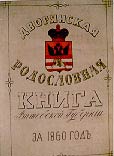Genealogy of the nobility

Information on the genealogy of the Belarusian nobility and gentry (shliakhta) can be
found in a number of general historical sources: parish registers, census records (gentry was included in those sources until 1816), the registers of municipal and Zemstvo courts of the Rech Pospolita, records
of judicial institutions of the Russian Empire and other sources. Moreover, there are
special historical sources on genealogy. They are kept in the fonds of the Noble Deputies
Assemblies (which existed in each province) and in the fonds of provincial and uyezd
marshals of the nobility.
The procedure of recognition and confirmation (approval) of shliakhta families of the
former Rech Pospolita as the noble families of the Russian Empire took place at the
nobiliary deputies’ meetings. Information on each family (which had to pass through this
confirmation procedure) is reflected in the protocols of the Commission on Confirmation,
in the family history records, and records on the nobility of the family.
Protocols of the Commission on Confirmation were made as soon as families proved their nobility. These protocols are subdivided into Protocols on Confirmation and Protocols on Adding. Protocols on Confirmation were made in the case of the first approval of the noble origin of the family (in the territory of the Russian Empire). They usually contain the following information: place of birth, place of residence of the ancestors, names of the first representatives of the family and their descendants with definition of their relationship (in the form of a genealogical tree), the name and description of the family arms, records on the property and land owning (the supported records on possession of manors or so-called mayentoks), on the holding of positions and others proofs of the nobility. Protocols on Adding contain information not only about the joining of individuals to the already recognized noble families, but also for all children and those who did not get into the “first recognition”. Protocols were made annually and were kept in the archives of the Noble Assemblies.
Family history records were compiled simultaneously with Protocols on Confirmation. Originally this was done annually, but later repeated every few years. The noble families were placed in the alphabetical order. Each family was represented in the form of a genealogical tree with a picture of the family arms. Near each branch of the tree, the generation description was given with reference to the records which proved the nobility. Each history was written in triplicate. Originals were kept in the fonds of the provincial Noble Assembly, the first copy – in the fonds of the provincial management board, the second copy was transferred to the Heraldry Department Archives in Saint Petersburg.
Records on the nobility of a family (or of a person) include documents which can prove the nobility, correspondence on the problems of submitting, registering and correcting these documents, checking of proofs, confirming and adopting the whole family in nobility, as well as adding individual persons and then adding other representatives of the family. The following records were usually considered to be the proofs: originals or copies of the extracts from registers, census records, parish registers, lists of families, and other documents. Usually, files contain copies of the protocols on confirmation and protocols on adding, Senate edicts, pictures of arms, genealogical schemes, any other information in existence from the moment the application for recognition was submitted, (as a rule, since1820 when people began to submit such applications in large numbers until 1917 when the last information on recognition was received). Archives of the Noble Deputies Assemblies preserved all files on the nobility. They were kept there so as both to confirm the nobility of families and for those persons who were transferred to the tax estates. The second copy of files of the confirmed noble families was preserved in the Archives of Heraldry department in Saint Petersburg.
The fonds of the Noble Deputies Assemblies which existed in the territory of the contemporary Belarus are kept in the following archives:
- Vitebsk province – in the National Historical Archives of the Republic of Belarus in Minsk (fond 2512). This fond includes 1130 files. The protocols and family history records have been preserved partly (approximately a half of the original number). The files on the nobility of families are totally lost. The fond of the provincial marshal of the nobility (fond 2626) contains electoral lists on elections to the different nobiliary institutions and some other records.
- Grodno province – in the National Historical Archives of Belarus in Grodno (fond 332). This fond is almost totally lost. It contains 45 files including records on the history of only two families for 1875 (letters B, C, G). The protocols of Commissions on Confirmation and files on the nobility are lost.
- Minsk province – in the National Historical Archives of the Republic of Belarus in Minsk (fond 319). This fond contains 5351 files including the protocols for practically all the years and the files on the nobility of about 4000 families. The family history records are lost. The fond of the provincial noble marshal office (fond 320) contains 1, 002 files including electoral lists, and other information.
- Mogilev province – in the National Archives of the Republic of Belarus in Minsk (fond 2066). This fond is almost totally lost. There are just 58 files, including several protocols of the Commission on Confirmation.

